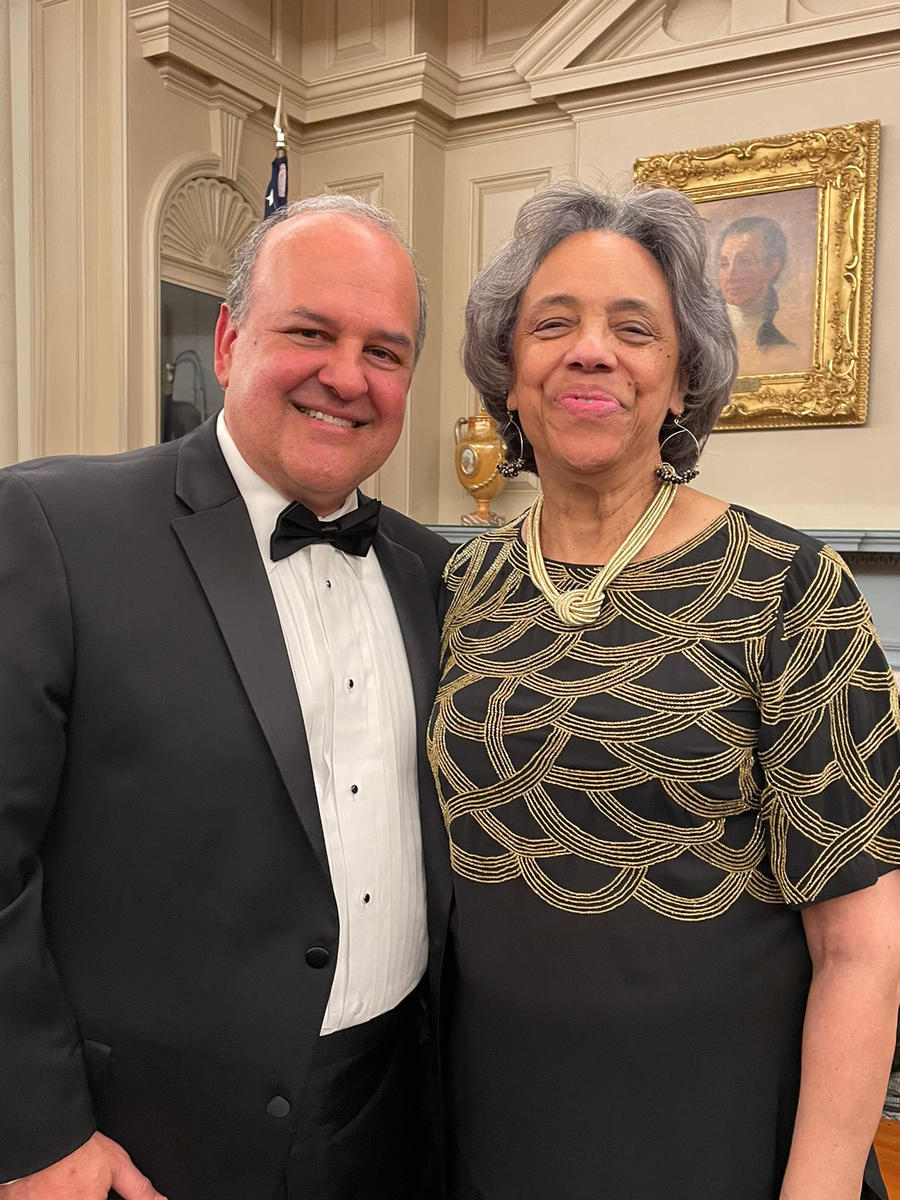The FS at 100—What Does the Future Hold?
Director General of the Foreign Service Marcia Bernicat talks about what’s next.
AFSA was delighted to host an “Inside Diplomacy” online conversation on April 8 with Director General of the Foreign Service and Director of Global Talent Marcia Bernicat. A career member of the Senior Foreign Service, Ambassador Bernicat previously served as acting assistant secretary for the Bureau of Oceans and International Environmental and Scientific Affairs and concurrently as the senior official for the Bureau of Economic Growth, Energy and the Environment.
The virtual audience of 217 included members of the Foreign Service community, journalists, students, and the public at large. AFSA President Tom Yazdgerdi facilitated the discussion along with Strategic Communications and Outreach Manager Nadja Ruzica. The following is excerpted from the transcript of the event. Find the entire discussion at https://bit.ly/Bernicat_Inside-Diplomacy.
AFSA President Tom Yazdgerdi: On May 24 this year, the Foreign Service turns 100. As we approach this milestone, we are taking stock of the state of the Foreign Service and also thinking about what the future might hold for this venerable institution and its people. And who better to discuss this than with today’s guest, the Director General of the Foreign Service and Director of Global Talent at State, Ambassador Marcia Bernicat, who assumed that role in May 2022.
Director General Marcia Bernicat: Thank you, Tom, and AFSA, for working with all of us to make the Foreign Service better and stronger. I don’t think we have ever had a better partnership between AFSA and the department, and I am so grateful to be your partner on this journey.
For me, to be Director General is a dream job, especially to be doing it at this point in time. We’re at such an inflection point in our nation’s history, in the history of the world. We are looking today at almost 14,000 Foreign Service employees. We serve over 250 missions around the world. If we go back a hundred years, the first class of Foreign Service officers was just 633 people. And when I joined 43 years ago, the Foreign Service was about 5,000 people strong. We’ve grown significantly over time, not just in terms of numbers but especially in terms of the wide variety and diversity of skills and experiences that we have brought in.
So, I’m not only pleased with where we are today in terms of the talent we possess but also very optimistic about the future.
AFSA: What are some of the biggest changes the Service has seen, in your experience?
MB: I’m a fan of our being every place we can be—the universalist approach—but if you consider the history of the Foreign Service, you were really on your own. You had your letters of instruction, but any correspondence, any guidance was oftentimes far enough away in time and distance that you had to be able to think on your feet.
One of the common threads we have throughout all this time is that we still require that our Foreign Service personnel are able to think, act, and make good decisions without necessarily being able to call home. And it’s true that we still face expeditionary challenges, most recently in opening our Pacific Island posts.
But as the last five or six years have taught us, we also have to develop a means by which we can track issues that have not traditionally been part of diplomacy. I’m thinking in terms of emerging technology. Five years ago, no one in this building was talking about AI. Now we’re about to have our own custom-built ChatGPT inside the State Department.
Similarly, our work on multilateral diplomacy. How we build coalitions in what has become in many ways a more multipolar world will require a much greater expertise there. And health—who would have thought that a pandemic would have presented [challenges] to our national security and to our economic security the way COVID-19 did? So we now have two new bureaus, one for emerging technology and one for health, that look at the diplomatic aspects of those issues.
AFSA: As we reflect on the past, what lessons have we learned over the last 100 years?
MB: We have learned over time to be far more agile.
People see those pictures of our predecessors, before and during World War II, sitting around in stately rooms having discussions. That still happens, of course, but we are so much more field-forward than we used to be, and the responses to crises are demanding that we find ways to be even more agile.
We are not just simply diplomats out there on our own. We are supported by our families, families who are with us at post and sometimes families who are back here in Washington, who we are learning to employ more creatively and more flexibly to augment what is a constant staffing gap. We’ve learned to value what our family members bring to the job that we’re doing.
AFSA: The Foreign Service Officer Test is no longer the pass/fail test it used to be, and the Foreign Service Officer Assessment is going virtual. Those are big changes. Can you please comment on that?
MB: We still have a written exam, but we came to realize that like every standardized test, there are some inherent biases that we worked hard to get rid of. We finally asked the right question: “Are we really looking for people who can take tests well?”
We haven’t done away with the test; it’s still a very important component. But rather than making it the first hurdle to overcome, we have now taken that score plus the essays that applicants write known as the QEPs [Qualifications Evaluation Panels], and whatever background and experience and skills our amazing applicants are bringing to the table. We look at the whole person.
It doesn’t favor you simply for being a good test-taker but rather also makes sure that we’re giving due weight right from the beginning to foreign language skills, having lived and worked overseas, any number of other skills and experiences that our applicants bring to make sure that we’re not losing them simply because someone may not score as high on the written test.
We are taking a leap that we took during COVID with Foreign Service specialists to have everyone take the assessment in a fully virtual format.
Imagine the number of people who can’t afford to come to Washington and/or just can’t afford to take that much time away from work. By offering everyone the assessment virtually, we are eliminating, again, another barrier to make sure that we’re getting the best and brightest candidates we can.
The other thing that really excites me is the fact that we are the first federal agency to offer all our internships on a paid basis. The ability to participate in an internship here in Washington or overseas was out of reach for so many people. Now we pay the round-trip fare, we pay a salary, and we provide housing because otherwise the salary would be completely eaten up in rent.
So we take all of that out of the calculation so that, again, we can get the most competitive candidates to come here, try us on. We get a chance to see what their skills are. I’m very excited about not only those two innovations but the fact that they are widening our ability to ensure that we’re getting the best candidates possible.
AFSA: On the paid internships—AFSA was a strong proponent, because it really does make a difference. We support that 100 percent.
MB: Thanks. And I’m sure, Tom, without AFSA’s support, we would have never gotten the funding from Congress to make it a reality. So thank you, thank you, thank you.

DG Bernicat with AFSA President Tom Yazdgerdi at AFSA’s Centennial Gala on May 21, 2024.
AFSA / Shawn Dorman
AFSA: How does the Secretary of State’s modernization agenda ensure that our diplomats have the new skill sets they need to be successful?
MB: We have to start with recruitment and hiring. We had by the summer of 2022 a deficit of 27 percent in the Foreign Service alone that was a result of the hiring freeze in the previous administration. When we did start hiring, we were hiring at less than robust rates.
President Biden made it clear he wanted to strengthen the foreign affairs workforce, so we have been hiring faster than any other federal agency, and we have the results to show. I just swore in an orientation class that has tied the record of the last three classes before it [as] the largest class we’ve taken in. We’re bringing in generalists and specialists together now; they begin their orientation together and then branch off for the different trainings that each one needs.
I use March 2020 as the benchmark because that’s when we went into quarantine, if you will, as a nation. Twenty-one percent of all serving Foreign Service personnel today have been hired since March 2020. So we are a very young Service, seniority-wise, even as our average entry ages picked up slightly to 36. We’ve partnered with FSI [Foreign Service Institute] to expand the amount of training that’s available as well as change the culture surrounding training. We started with getting from Congress additional, full-time equivalent positions to support a bigger training float to go well beyond foreign language.
FSI is busy expanding its course offerings, particularly for less traditional subject matter like cyber; science, technology, engineering, and math (STEM) issues; health; and climate expertise.
We also looked at what someone in the mid-level would need in terms of training and exposure in order to tee them up successfully, not only to lead as a mid-level employee but also to be competitive to get into the Senior Service. We worked with FSI on launching a mid-level training curriculum, a series of courses beyond mandatory training. Our leadership training remains mandatory.
But we knew we couldn’t just offer more training. We also had to help change the culture. Too often people think of training as a wasted year, in that it’s a year they don’t have information to add to their EERs that will make them more competitive for promotion.
And so we introduced two things: first, a learning policy which urges supervisors to provide at least 40 hours a year of training time for their staff. I would say, let’s expand this, make it 52 hours in the year, where people can either delve into a new subject matter or use 40 hours in one swoop to take a course they might not otherwise get to take.
They can use it to attend seminars in town or virtually, the idea being some time dedicated to voluntary learning that not only helps you expand your skills but also has the added advantage—and this is the best practice in the private sector—of taking you away from the daily grind of your work and giving you a chance to sit back, relax, and, in a stress-free environment, take on some additional learning.
Second, we have brought back multifunctional promotions. One of the activities that will count toward a multifunctional promotion will be long-term training. We want to give people some reward for taking time out of their career to expand their knowledge base.
I know it involves a culture change, but if we don’t learn, if we don’t keep adapting, as the Secretary has pointed out, we’re going to find it increasingly difficult to do our work in such a dynamic world as we’re living in today.
AFSA: Looking to the future, what change do you hope to have in place?
MB: [We need] to make sure that we are bringing in the most diverse set of employees we can. We recruit for diversity, meaning I want to go to every corner of the country. We want to raise awareness but also spark the imaginations both of adults and students, that they, too, can represent their country overseas.
I want us to be an inclusive employer—always on merit but making sure that we’re gathering the widest possible and most diverse set of employees, and that’s from every aspect. Surely our race and our gender play huge roles in forming our worldview. But so does where we grew up, the schools we attended, our birth order. All those aspects of our diversity provide the kind of agility that we’re going to need as the world becomes smaller.
[As far as technology is concerned,] the changes are coming faster all the time. I can’t even imagine where we’ll be a year from now, much less in 50 years, but I’m confident technology will play a huge role.
AFSA: What could we do better when it comes to raising awareness among the American public about what the Foreign Service does and why it is so vital?
MB: I urge all our colleagues, active duty and retired: Don’t stop talking about us. Go to your own organizations, volunteer to talk at other organizations and in our schools to explain what it is that we do and how we do it.
AFSA: What is being done to retain Foreign Service members?
MB: Historically, the State Department has had very low attrition rates. Currently, we have the third-lowest attrition rates in the U.S. government.
Our Foreign Service attrition rate is only about 3 percent, which is almost attrition for retirement. But when Secretary Antony Blinken came to office, he asked about who’s leaving and why, which was the exact right question.
Because of his question, we set up a retention unit. We were able to track that our attrition rates were almost identical for men and women until about the 10-year mark, when the attrition rate would significantly increase for women. And to be honest, among women, the highest attrition rates are among women of color.
Many of our employees are being sandwiched between taking care of or preparing to put children through college while also beginning to take care of parents who are starting to age or becoming frail. And some of our employees from historically underrepresented groups may also come from families where there is less accumulated wealth, so they were also being sandwiched by siblings or other relatives who needed support.
The Googles and the Microsofts of the world come along and offer much higher salaries.
We have found that a number of people who went off to those private sector jobs are having buyer’s remorse, and so we’ve stepped up our program that allows people to come back into the Foreign Service and be reappointed, because even though the salary was a lot greater [elsewhere], they believe that what they do [at State] contributes in a meaningful way.
AFSA: What is your best advice to students who are looking toward a future in the U.S. Foreign Service?
MB: I promise that whatever field of study you’re interested in, we can use the skills you’re going to gain from that field of study. Figure out again what excites you. Pursue that and then come to us.
When sharing or linking to FSJ articles online, which we welcome and encourage, please be sure to cite the magazine (The Foreign Service Journal) and the month and year of publication. Please check the permissions page for further details.
Read More...
- “Building a Foreign Service for 2025 and Beyond” by Arnold Chacón and Alex Karagiannis, The Foreign Service Journal, May 2015
- The Future of the Foreign Service—As Seen Through the Years, The Foreign Service Journal, September 2018
- “Welcome, Director General Bernicat! AFSA Stands Ready to Work with You” by Eric Rubin, The Foreign Service Journal, September 2022



